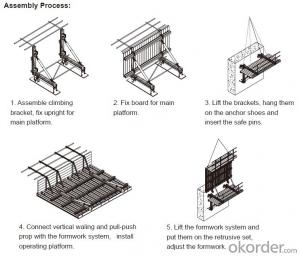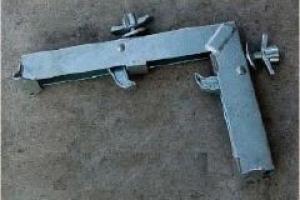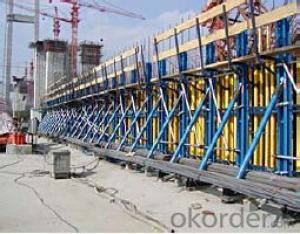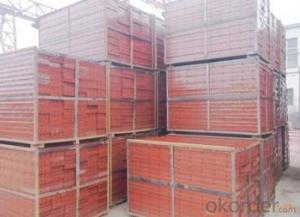Auto Climbing Bracket ACB100&ACB50 for formwork and scaffolding systems
- Loading Port:
- Tianjin
- Payment Terms:
- TT OR LC
- Min Order Qty:
- 50 m²
- Supply Capability:
- 1000 m²/month
OKorder Service Pledge
OKorder Financial Service
You Might Also Like
Auto-climbing Bracket ACB100 & ACB50
The power of the auto-climbing formwork is the hydraulic system, which includes the oil cylinder
and two commutators. The commutators can control the climbing of climbing rail and the bracket.
The steel rail and the bracket can inter-climbing, so the whole system will climb up steadily.
Cranes are not needed during the construction. It’s easy to operate, highly efficient and safe. It’s
the best choice for the construction of high buildings and bridges.
There are mainly two types of standard auto-climbing brackets, ACB-50 and ACB-100, the figure
means the push power of cylinder with unit of KN.
Characteristics:
◆ Perfect load bearing anchor system
Anchor system is the most important supporting part. The system is made of five parts shown
below. Thereinto, tensile bolt, V-climbing cone and washer can be taken out for reusing after the
concrete pouring finished.There are two kinds of anchor systems,A & B. A is matched with single
anchor shoe and B is matched with double anchor shoe.
◆ Crane-independent
Crane-independent forming, striking and climbing speeds up the work procedures on the
construction site and also makes them independent of each other. This means the planned
sequences can be maintained along with guaranteeing high productivity levels. The crane can
therefore be used for other tasks.
Hydraulic system is mainly made of two commutators,
oil cylinder and power distribution system.The
commutators can control the climbing of climbing rail
and bracket.
◆ High bearing capacity and safe
The stable working platforms are able to carry large loads, e.g. the storage of reinforcing steel
for the next climbing section. Generously-sized working platforms, the well thought-out design for
handling very high wind loads and the patented control function of the climbing mechanism are
some of the special details contained within the comprehensive safety concept.
◆ Platforms adjusted to suit the angle of inclination
The horizontal working areas thus created provide safe and comfortable conditions for
reinforcement work, shuttering and striking, concreting and finishing.
◆ The ACB formwork system can climb not only vertically but also slantways, the largest angle is
18 degrees.
◆ The system can climb up wholly or separately. The climbing process is steady, synchronous
and safe.
◆ The bracket will not fall to the ground until the construction is finished, the field will be saved
and the impacting breakage will be reduced (especially the panel).
◆ The system will furnish omnidirectional platform, the construction organizations don’t need to
set up additional operation platform.
◆ The error of structure construction is small and easy to correct.
◆ The climbing speed is fast, the construction course will be quickened.
◆ The formwork can climb itself and cleaning work can be done in the same situs , the used times
of tower crane will be greatly reduced.
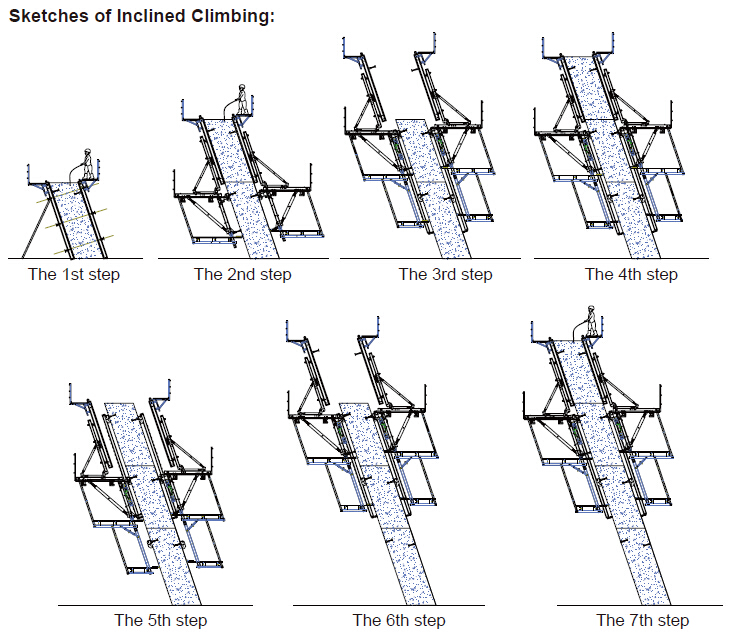
- Q: What are the considerations when designing steel formwork for columns?
- There are several important factors to consider when designing steel formwork for columns. These factors include the size and shape of the column, the load it will bear, the height of the column, the desired finish of the concrete, and the availability of labor and equipment. To begin with, the dimensions and configuration of the formwork will be determined by the size and shape of the column. The formwork must be able to accommodate the specific dimensions of the column, including its diameter or width, as well as its height. It may need to be adjustable or modular to fit different column sizes and shapes. Additionally, the ability of the formwork to withstand the weight of the concrete and any additional loads is crucial. It must be designed to support the weight without deforming or failing, ensuring the structure's integrity and safety. The height of the column is also a consideration in formwork design. Tall columns may require extra support or bracing to prevent buckling or collapsing. The formwork should be designed to provide sufficient stability and strength throughout the column's height. Furthermore, the desired finish of the concrete is an important factor to keep in mind. If a smooth or architectural finish is desired, the formwork must be designed to create a smooth and even surface. This might involve using special form liners or coatings to achieve the desired finish. Lastly, the availability of labor and equipment should be taken into account. The formwork design should consider how easy it is to assemble, disassemble, and transport. It should be practical and efficient to install and dismantle, taking into consideration the labor and equipment available on the construction site. In conclusion, when designing steel formwork for columns, it is important to consider the size and shape of the column, the load it will bear, the height of the column, the desired concrete finish, and the availability of labor and equipment. By carefully considering these factors, the formwork can be designed to meet the specific requirements of the project, ensuring a safe and efficient construction process.
- Q: Can steel formwork be used for curved beams and columns?
- Yes, steel formwork can be used for curved beams and columns. Steel formwork is versatile and can be easily adjusted or shaped to match the desired curvature of the beams and columns. Its strength and rigidity allow it to maintain its shape during the concrete pouring process, ensuring accurate and precise results for curved structures.
- Q: What are the different types of finishes applied to steel formwork surfaces?
- There are several types of finishes that can be applied to steel formwork surfaces. These finishes are designed to enhance the appearance, durability, and performance of the steel formwork. Some of the most common types of finishes include: 1. Galvanized Finish: This is a popular finish for steel formwork surfaces. It involves coating the steel with a layer of zinc, which provides excellent corrosion resistance. Galvanized finishes are often used in outdoor or high-moisture environments. 2. Powder Coating: Powder coating is a process in which a dry powder is electrostatically applied to the steel surface and then cured under heat. This results in a hard, durable finish that is resistant to chipping, scratching, and fading. Powder coatings are available in a wide range of colors and textures. 3. Paint Finish: Paint finishes are commonly used to enhance the aesthetics of steel formwork surfaces. They provide a smooth, uniform appearance and can be customized to match specific color requirements. Paint finishes also provide a level of protection against corrosion and weathering. 4. Epoxy Coating: Epoxy coatings are known for their excellent chemical resistance and durability. They are often used in industrial applications where the steel formwork may come into contact with chemicals, acids, or solvents. Epoxy coatings also offer good adhesion and abrasion resistance. 5. Anodized Finish: Anodizing is a process in which a layer of aluminum oxide is formed on the surface of the steel formwork. This finish provides enhanced corrosion resistance, as well as a decorative appearance. Anodized finishes are commonly used in architectural applications. 6. Stainless Steel Finish: For some steel formwork applications, a stainless steel finish may be preferred. Stainless steel is inherently corrosion-resistant and has a sleek, modern appearance. It is often used in environments with high humidity or exposure to chemicals. These are just a few examples of the different types of finishes that can be applied to steel formwork surfaces. The choice of finish will depend on factors such as the intended use of the formwork, the desired aesthetics, and the environmental conditions it will be exposed to.
- Q: What are the different types of formwork ties used in steel formwork?
- Some of the different types of formwork ties used in steel formwork include snap ties, wedge ties, coil ties, and flat ties. These ties are used to secure the formwork panels together and provide stability during the concrete pouring process.
- Q: Can steel formwork be used for underwater concrete structures?
- Underwater concrete structures can indeed utilize steel formwork. The durability, strength, and ability to endure harsh environmental conditions are well-known attributes of steel formwork. When employed for underwater concrete structures, steel formwork supplies a dependable and stable framework for pouring and molding the concrete. It can endure the water's pressure and forces, ensuring precise containment and desired shaping of the concrete. Furthermore, steel formwork displays resistance to corrosion, a crucial factor in underwater environments where the probability of rusting is elevated. In summary, due to its strength, durability, and corrosion resistance, steel formwork proves to be an appropriate choice for underwater concrete structures.
- Q: How does steel formwork affect the overall seismic performance of a structure?
- Steel formwork can significantly enhance the overall seismic performance of a structure. Its rigid and robust nature provides excellent strength and stability, which helps resist seismic forces during an earthquake. Steel formwork ensures precise alignment and accurate concrete placement, resulting in a structurally sound and well-connected system. This reduces the risk of structural failure, enhances load-bearing capacity, and improves the overall resilience of the structure against seismic events.
- Q: How does steel formwork affect the overall timeline of a construction project?
- Steel formwork can have a significant impact on the overall timeline of a construction project. One of the major advantages of using steel formwork is its durability and reusability. Unlike traditional timber formwork, steel formwork can be used multiple times, which reduces the time spent on constructing and dismantling formwork for each concrete pour. The strength and rigidity of steel formwork also allow for faster construction cycles. Since steel formwork can withstand higher concrete pressure, it enables faster pouring and setting of concrete, leading to shorter curing times. This, in turn, allows subsequent construction activities to commence earlier, ultimately accelerating the overall project timeline. Moreover, steel formwork is known for its precision and dimensional stability. It provides a smooth and accurate surface finish, eliminating the need for additional plastering or leveling work. This saves time and reduces the number of construction activities required, further enhancing the project timeline. Additionally, steel formwork is typically prefabricated, meaning it is manufactured off-site and delivered to the construction site ready for assembly. This significantly reduces on-site construction time, as the formwork can be quickly erected and adjusted to the desired shape and dimensions. This timely installation ensures that other trades can progress with their work without delays, ultimately speeding up the overall construction process. However, it is important to note that the initial setup time for steel formwork can be longer compared to other types of formwork, as it requires careful planning and coordination. The formwork design must be accurately calculated, and any modifications or adjustments may take additional time. Nevertheless, the time saved during subsequent concrete pours and other construction activities usually compensates for this initial setup period. In conclusion, steel formwork positively impacts the overall timeline of a construction project by reducing the time spent on constructing and dismantling formwork, enabling faster concrete pouring and curing, providing a precise and finished surface, and facilitating quick and efficient on-site assembly. Its durability and reusability contribute to a more efficient and timely construction process, resulting in a shorter overall project duration.
- Q: What are the common problems encountered with steel formwork?
- Some common problems encountered with steel formwork include rusting or corrosion, damage due to mishandling or improper storage, difficulty in handling and assembling due to its heavy weight, and potential for warping or bending under pressure.
- Q: How does steel formwork handle formwork stripping and reassembly?
- Steel formwork is highly effective in handling formwork stripping and reassembly due to its strength, durability, and versatility. When it comes to formwork stripping, steel formwork systems are designed to allow for easy and efficient removal of the formwork after the concrete has set. The steel panels can be easily detached from the structure, and the formwork components can be disassembled without causing any damage to the formwork system or the concrete structure. Steel formwork also offers quick and effortless reassembly capabilities. The panels can be easily repositioned and locked back into place, ensuring a precise and accurate alignment for the next concrete pour. The interlocking mechanism of steel formwork allows for a tight and secure connection, preventing any movement or displacement during the pouring and curing process. Moreover, steel formwork is known for its reusability. Unlike traditional timber formwork, steel formwork can be used multiple times without compromising its structural integrity. This not only makes it cost-effective but also reduces the environmental impact associated with formwork waste generation. Another advantage of steel formwork is its adaptability to different project requirements. Steel panels can be easily modified or customized to accommodate complex shapes, angles, or curves, providing flexibility in various construction applications. This adaptability ensures that steel formwork can handle the stripping and reassembly process efficiently, regardless of the project's design complexities. In summary, steel formwork is a highly reliable and efficient choice for handling formwork stripping and reassembly. Its strength, durability, reusability, and adaptability make it a preferred option in the construction industry, allowing for seamless and hassle-free formwork operations.
- Q: What are the typical sheet thicknesses used in steel formwork panels?
- The typical sheet thicknesses used in steel formwork panels vary depending on the specific application and requirements, but they commonly range from 2mm to 6mm.
Send your message to us
Auto Climbing Bracket ACB100&ACB50 for formwork and scaffolding systems
- Loading Port:
- Tianjin
- Payment Terms:
- TT OR LC
- Min Order Qty:
- 50 m²
- Supply Capability:
- 1000 m²/month
OKorder Service Pledge
OKorder Financial Service
Similar products
Hot products
Hot Searches

